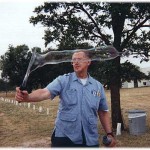Au Revoir Junction – 1989 – 1998
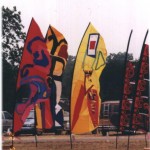 There are certain events that seem to have achieved ‘mythic’ proportions in the lexicon of the kite world. The Memorial Day weekend Retreat held in Junction, Texas is one – especially for those of us who inhabit the rarefied air of single line kite making. This year, after ten years of fostering creativity, the Junction International Kitemaking Retreat has retired. The creation and ‘child’ of Betty Street and Bill Lockhart, Junction was born out of contacts with Malaysian kitefliers, who having seen the ripstop kites of visiting Americans, requested help in teaching their kitefliers how to use this non traditional material. Betty and Bill were invited to teach in Malaysia. At this time there were no workshops in Texas, and not that many kitemakers. They saw this as an opportunity to introduce east to west and vice versa. So with the cooperation of Malaysian Airlines, who sponsored the Malaysian kitemakers, they put together the first Junction experience in 1989.
There are certain events that seem to have achieved ‘mythic’ proportions in the lexicon of the kite world. The Memorial Day weekend Retreat held in Junction, Texas is one – especially for those of us who inhabit the rarefied air of single line kite making. This year, after ten years of fostering creativity, the Junction International Kitemaking Retreat has retired. The creation and ‘child’ of Betty Street and Bill Lockhart, Junction was born out of contacts with Malaysian kitefliers, who having seen the ripstop kites of visiting Americans, requested help in teaching their kitefliers how to use this non traditional material. Betty and Bill were invited to teach in Malaysia. At this time there were no workshops in Texas, and not that many kitemakers. They saw this as an opportunity to introduce east to west and vice versa. So with the cooperation of Malaysian Airlines, who sponsored the Malaysian kitemakers, they put together the first Junction experience in 1989.
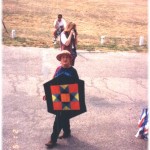 Since then, Junction has consistently maintained this Eastern connection and every year has seen masters of traditional Asian kitemaking teaching and learning side by side with some of the finest contemporary kite artists from North America and Europe. As well as attracting Texas kitefliers, Junction soon became a mecca of creative expression for kitemakers from all over the world.
Since then, Junction has consistently maintained this Eastern connection and every year has seen masters of traditional Asian kitemaking teaching and learning side by side with some of the finest contemporary kite artists from North America and Europe. As well as attracting Texas kitefliers, Junction soon became a mecca of creative expression for kitemakers from all over the world.
There are many wonderful annual workshop weekends held all over the country: MAKR in Illinois, Fort Worden in Washington, and OKR in Oregon to name a few, but Junction…..well, Junction was different. No clubs, no committees, no kits and no compromise. Junction was spearheaded by two talented artists/art educators and as a result, the focus at Junction has always been the creative expression of flight. Under the umbrella of Texas Tech University, where Betty and Bill have taught for years in the art education department, they were able to create a magic oasis of kite creativity in ‘the middle of nowhere’. The Retreat is held two hours from San Antonio on a 416 acre campus on the South Llano River. It is located on a property that serves as a summer school campus and conference centre for Texas Tech.
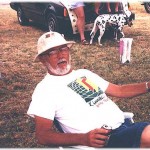
Much of what was Junction was dictated by this marvelous property. The summer campus sits in a flat, grassed, 40 acre flying field, surrounded by slightly treed hills. A perfect kite flying venue. There are small dorm buildings scattered around, each one with a classroom attached. In addition, there is a cafeteria, main classroom building and store, and all this is backed by a picturesque, tumbling river fringed by fields that are sometimes full of wildflowers in May. If you are tired of flying, or need a break from a class, you take a short walk through the woods to the river for a refreshing swim or a few minutes of private contemplation. On your walk you may pick up one or two ‘holey’ rocks to use as a ripstop weight, or to put on a bit of kiteline for a necklace. Finding ‘holey’ rocks is very much a part of a Junction experience.
You can only take one workshop a day at Junction, so there is no rush or crush to get things done and rush off to another class. The workshops are open at all hours, so you can work when and how you want. Each workshop giver retains the same facility for the duration of the weekend and they tend to hang around, working on new ideas of their own, helping out when you need it. It’s like being able to work side by side with an artist in his/her own studio.
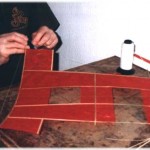
Another really special feature at Junction was the dedicated support staff of volunteers made up of Texas Tech faculty and students, who came back year after year to help with the retreat. In addition there were the familiar faces of the cafeteria staff and groundspeople, who fed us well, set up anchors all over the 40 acre field, and who created the substructure that made things go so smoothly… There had been rumours that this might be the last Junction, but there had been rumours before and here we were again. At our first dinner in the Cafeteria, Betty got up and made the announcement. Both she and Bill had been retired for several years but had continued to teach part time. This had given them access to the Junction campus. Both were now totally retiring, and Betty was looking forward to a summer off for the first time in over twenty years. It was final, and there would be no revival. All the kite making material in the store would be sold off in a sale at the end of the weekend.
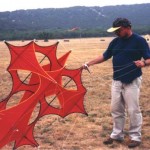
Did the announcement make a difference to the ambiance of the weekend? In retrospect I felt it did. There was a melancholy contemplative air, especially amongst those who had attended all ten years of workshops. They could be seen picking up their last holey rocks, wandering down to the river for what might be their last visit, or seen quietly flying their kites off in the distance of the huge flying field. As usual, wonderful air borne creations emerged from the workshops and filled the skies at odd moments: asymmetrical kites from Robert Trepanier’s workshop; hot air balloons from Martin Lester’s; ‘holey’ fighters from Willi Koch’s; miniatures from Scott Hampton’s; flurries of ‘Baus’ from the Malaysians. There were some special moments too: An evening of slides by ‘kite makers that have influenced me’ was hosted by Bill Lockhart. It was illuminating and inspiring to see how much Peter Malinski and his kites have influenced kite artists all over the world. His work appeared again and again in the slide sets of different contributors.
The weekend culminated in a silent and ‘loud’ auction. It had been announced that moneys from the auction would be held in trust by Drachen Foundation to be directed at further fostering originality and creativity in kitemaking. The star of the auction was a Betty Street kite. Betty does not part with her kites. Ever. This was a first, and bidding for the exquisite patchwork ‘skink’ (Junction lizard) was active. The auction raised a record amount of funds to be put toward futhering the Junction “mission”.
The weekend also saw a meeting of the AKA Kite Art Committee. Jim Murasako agreed to chair the Kite Art Committee after Janene Evard steps down. Rumour has it that this committee will be looking at developing biannual weekend workshop that will attempt to carry on the intent to foster creativity in flight that has characterized the Junction experience. Betty announced Friday at Junction that the auction surplus, (if any), would be donated to the Drachen Foundation. They may be interested in supporting further kite retreats, but have not committed any funding yet.
I can think of no better way to end this article than with a list of some of the workshop teachers that have contributed to making Junction so special over the years. In no special order they are;
Bill Lockhart, Betty Street, Charlie Sotich, Scott Hampton, Jose Sainz, Scott Skinner, Hugh (Stretch) Tucker, Peter Lynn, Martin Lester, George Peters, Mrs. Tokuko Sato-San, Ed Lindsay, Spencer Chun, Robert Trepanier, Achim Kinter, Stafford Wallace, Martyn Lawrence, Mikio Toki, Morihiro Takeda, Stuart Allen, Michael Alvares, Willi Koch, Romeo & Donald Collado, Shigeki Endoh, Jorgen Moller Hansen, Peter Malinski, Masaaki Modegi, Dan Proebstel, Dawn Williams, Stan Swanson, Lee Toy, Elmer Wharton, Tony Wolfenden, Alberto Alberighi, Hideo Matsutani, Mohd Nasir Othman, Wolfgang Schimmelfennig, Joel Scholz, Teruaki Tsutsumi, Joe Vaughan, Raoul Fosset, Steve Brockett, Joe Hadzicki, Sam Huston, Dan Kurahashi, Bobby Stanfield, Carlos Us, Azahar Hamid, Chang Loo Hin, Anne Sloboda, Satoshi Hashimoto, Bodoczky Istvan, Tom McAlister, Jo Nilsson, Ali Fujino, Marco Coyote Olcot, Marc Ricketts, Rafael Coyote Tum, Basir Beria, Jeff Howard, Lisa Schirmer, Ezanee Yusoff, Za
karia Mat, and many more…
Thanks Betty and Bill.
Elain Genser
soda-bear
nanaimo b.c.

